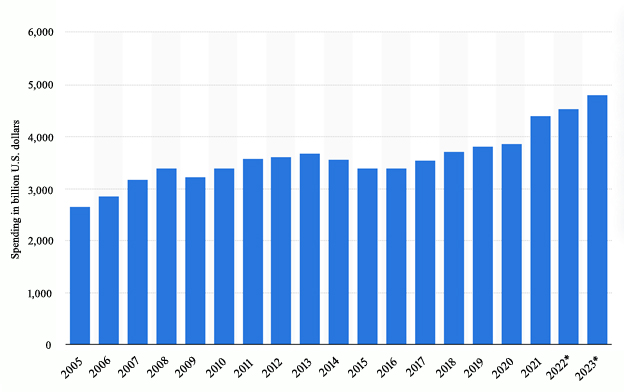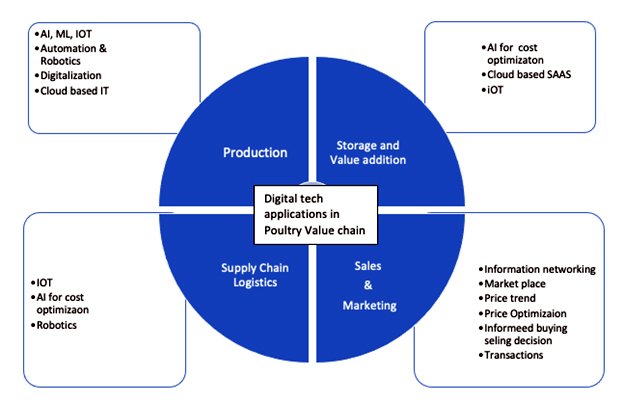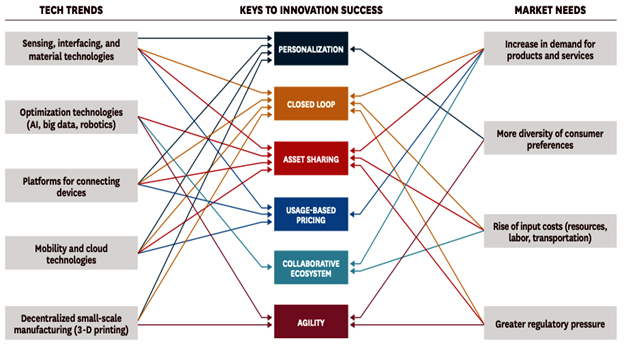Indian Poultry Sector: At a glance: The Indian poultry Sector has over the years grown exponentially and is playing a significant role in contributing to India’s Gross value added among all the primary sectors. The sector has witnessed a whopping growth in the last 10 years at a compounded annualized growth rate ( CAGR) of 7.5% with a cumulative revenue of ~ INR 130 Billion producing ~ 6+ Million MT of Broiler meat and ~90 billion edible eggs annually. The Indian poultry sector generates direct and indirect employment to more than 5 million rural and urban Indians, contributing to 5% of Agriculture GDP. The production efficiency in the poultry sector has improved significantly over the last one decade. The feed conversion ratio in broiler meat production has come down to 1.55-1.6 against 1.8-1.9 a decade ago with an efficiency improvement of ~14%. Similarly, in the layer and breeder sector as well, the hen housed eggs and hen housed hatching eggs has improvised to a great extent.

Co-founder and CEO of “Utpan“,
Today a layer bird during her economic life cycle is able to produce 330 edible eggs and a breeder bird lays about 180 eggs in her economic life cycle of 68-70 weeks.
The depth of the Indian Poultry sector and its contribution to the nation is known to all within the sector and beyond with the growing traction, growth and developments in the sector. The poultry sector has been projected to grow at a CAGR of 7% in next five years generating employment to more than 7.5 Million people of the country.
Growth potential in the Indian poultry industry sector provides a platform to each and every individual entity and stakeholder of the sector an equal opportunity for growth. However, the growth of stakeholders like individuals or businesses in the sector depends a lot on the future business strategy, sustainable growth focus, resilience, and adaptability with the changed trend in consumer behavior. There are several internal and external macro and micro factors which are going to play significant role in driving an entity towards its growth trajectory, but in this article we will focus on one crucial aspect of this new aged business with digital transformation.
This article would intend to outline the role and importance of digital transformation in Indian poultry sector.
What is Digital Transformation :
Digital transformation, in the business landscape, refers to the adoption of digital technologies to modify or enhance traditional business methods and processes, e.g. same grocery shopping that used to be a mandatory trip to a nearby shopkeeper is now enhanced to 10 minute doorstep delivery of the same products. These technological innovations help to simplify processes, increase revenue and efficiency, and accelerate growth and scalability of business.
There are different ways in which a company can implement digital transformation. It varies, depending on the nature of the business. An eCommerce platform can introduce technology to deliver products or services digitally. A retail store can analyze customer data to improve its digital offerings. Since digital technology is a consistently developing field, their adoption is no longer a one-off event but an ongoing process.
In 2022, the spending on digital transformation technologies is estimated to reach $1.8 trillion, as per Statista, which is a clear indicator of the emphasis being laid by organizations on these in order to improve their bottom lines. Given the large-scale transition of business processes and the global economy to the online domain, digital transformation is of crucial importance for every business owner.
Digital Transformation practices in new aged businesses
Cloud Technology: Cloud technology has gained immense popularity in recent years. Instead of on-premises data centers, organizations have shifted their focus to cloud services, encouraging a large-scale digital transformation for organizations worldwide. After several iterations, cloud technology is all set to disrupt business operations and allow organizations to access data from anywhere in the world, at any time. Consequently, employee efficiency will increase due to the elimination of physical barriers, as they collaborate on projects. There is no longer a need for organizations to have their employees travel from one location to another, or to invest in physical infrastructure. Moreover, cloud computing makes storing large amounts of data easier, enabling remote access when needed.
Artificial Intelligence and Machine Learning: AI has evolved rapidly in the past decade, leaving a tangible impact on many sectors of the economy, such as healthcare, communications, automotive, financial, and technology services. It has brought a change in the way people do business, by automating business processes, enhancing customer engagement, analyzing data to deliver insights, streamlining hiring and recruitment, organizing billing and invoicing, and more.
This is a leap beyond big data analytics, which has tremendously bolstered growth of several industries, by generating consumable insights like market trends of consumer behavior etc. leading to outcomes like right targeting of marketing ads, product portfolio to right customer persona at the right time of the day.
The use of AI-powered marketing automation software has risen tremendously. Marketers are inclined towards marketing and sales tools backed by artificial intelligence and are including them in their digital transformation strategy. For instance, AI allows marketers to save a lot of time that was otherwise spent on crafting personalized content experiences.
A 2021 survey concludes that 76% of organizations have prioritized AI and ML over other IT solutions. Organizations are prompted to become more efficient, and this desire drives them to automate tasks for enhanced productivity.
Hyper Automation: One of the significant advantages of digital transformation is automation. It lets businesses reduce the workload of their employees, organize and automate certain processes, and optimize productivity and performance. Automation tools have existed in the digital world for a while. The next step in this is the development of hyper automation. In simple words, hyper automation enriches the automation and makes it efficient. It facilitates accelerated growth and business resilience by immediately identifying, assessing, and automating as many processes as possible.
The technology relies on a combination of artificial intelligence, machine learning, and robotic process automation. The tools assess and manage business processes by analyzing structured and unstructured data to deliver valuable insight into opportunities for improvement and better optimization.
Additionally, hyper automation algorithms evaluate large volumes of data easily, which is not possible for humans. These tools can give comprehensive observations and connotations between background processes that teams and departments in the company cannot otherwise identify.
Blockchain Technology: Most people associate blockchain technology with cryptocurrencies. But its scope of use is vast, especially in businesses. The most prominent feature of blockchain is enhanced security, due to its fixed records. However, the technology also impacts the way organizations handle contracts and transactions, work with partners, and manage supply chains.
Non-fungible tokens gained immense popularity last year. NFTs are unique digital collectibles that are traded like any other asset class. Currently, the primary focus of NFTs is on digital art and games, but they can also be useful in the areas of stocks, bonds, real estate, and data ownership rights.
The Hybrid Work Model : integrated solutions
In 2022, the hybrid work model became the new normal. Organizations are now becoming more agile and flexible in adapting to the requirements of evolving times. Employees can now choose to work from the office or from home at their convenience. A LinkedIn Future of Work report revealed that 86% of Indian professionals prefer a hybrid model as it allows them to strike a balance between their personal and professional lives.
To facilitate such a working arrangement, organizations must adopt digital workplace technologies that let the management and employees organize their day-to-day activities, work efficiently and collaborate effectively irrespective of their location.

Digital transformation has progressed from a boardroom buzzword to a critical strategic priority, but the industry is still in its infancy. According to IDC, global investment in digital transformation will grow at a compound annual rate of 17.1 percent, reaching a staggering $2.3 trillion (53 percent of all ICT spending) by 2023. The United States will be the largest spenders in the digital transformation space, followed by Europe and then China and India. With over 500 million internet users, India is one of the largest and fastest-growing digital consumer markets, but business adoption is uneven. As digital capabilities improve and connectivity becomes more ubiquitous, technology is poised to rapidly and dramatically alter nearly every sector of India’s economy. This is likely to have a significant economic impact as well as change the nature of work for millions of Indians.
Digital transformation in Indian poultry sector:
Irrespective of their size of the businesses, for several years now, digital transformation has been an objective for many organizations within the poultry sector, and yet has been neglected due to competing priorities. Earlier, it took years for an organization to build and implement a technology-driven strategy, however, with the onset of the Covid-19 pandemic and its impact on businesses, the pace of adopting the latest digital transformation trends is multifold. Additionally, the dependence on the relevant technologies, such as machine learning, SaaS products, artificial intelligence, cloud computing, and more, has also resulted in accelerating advancements and democratization.
Application of digital technology in the value chain of poultry sector:
The value chain of poultry production from pure-line genetics to commercial farming, processing and value addition to marketing is itself a vast area for applications of digital technology at each level.

In the recent years, there has been a significant development in the Indian poultry sector in the area of production and usage of technology in optimizing production efficiencies. However, the usage of disruptive technology and data based information systems in the marketing of poultry produced are still very limited.
Linking Technology and the market:
The recent developments in the digital marketplace initiative in the poultry and related sector focuses on bringing the farmers and the buyers together on a single platform, and interacting with each other for an optimal buy and sell of their produced goods.

It is important for the farmers and producers to be connected with the market and buy or sell the produced while making well informed and timed decisions.
Building Digital Layer in the Buyers and Sellers Market
For any farmer/producer and seller, there are several information sources and data points that can impact the profitability of each batch/produce : ranging from the crop type and placement time decisioning, batch or placement sizes, quantity and quality of input options and selling prices benchmarked with market trends.
These information sources enable users to carry multiple offline transactions to grow the crop/produce and build the business while transacting with other businesses across the value chain : input providers, logistics partners, financers, buyers etc.
In the current day, a significant number of these transactions are uninformed decisions due to lack of timely data on market trends, inconsistent supply and demand information through disparate sources, and lack of trusted buyers or sellers.
There is also a lack of digital records and transaction history of sellers and buyers, which can otherwise substantiate the strength of the business and track record for viable financing options through Financial Service Providers in Agri space.
Digital transformation enables a simple layer of technology over the existing traditional practices in the value chain of agri and allied sector’s buying-selling activities to ensure timely availability of the data enabling informed decisions.
Digital data infrastructure of record keeping and analysis can extend to credit analytics, buyer seller match making, contextual crop advisory with verified data made available to required financial service providers in agri space.
For example, in a study conducted by ThinkAg, a platform for Agri and food innovation, it was revealed that only 30% of the farmers get access to finance from formal sources, while about 50% of the small and marginal farmers are unable to borrow from any source.
Innovative ways to create digital records for the transactions by these farmers can enable build and improve the traceable business transaction track records of the users with thin or no credit histories.
Digital technology in the poultry market place aims to build data to substantiate & measure the strength of the businesses by leveraging on records & transactions and sales via both offline & online medium, enables users to perform day to day activities involved in buying/selling, price trend checks and comparisons, crop listings, transactions of produce to increase digital touch points across value-chain : covering buyers, sellers and ancillary solution providers.
Digital initiative in Poultry Industry
While looking at the poultry industry trends over the last few years, this industry happens to be the most promising industry in the agriculture sector, providing livelihood through many small, medium and large-scale companies. However, there has been a gap in the information symmetry at both Producer/Supplier & Buyers end as the data is disparate, scattered.
One of the key problem statement of this industry is disparate and offline data sources and digitally captured structured data can solve following three issues impacting poultry industry :
- disparate data and delayed information leading to inefficient decisions of placement and selling
- lack of direct connectivity between reliable producers and buyers leading to skewed demand and supply
- lack of transaction records to substantiate performance of businesses and finance availability
The unavailability of timely data through offline channels leads to two major concerns :
- Gap & delay in the data/information availability for daily rates, supply & demand across markets
- Lack of reliable transaction data for underwriting even for the well performing producers and small businesses
This digitization can enable efficiencies across business processes, revenue potential and availability of financing options similar to benefits seen in other sectors like supply chain solutions in the country enabling remote and reliable tracking and creating of alternate data available to build trust and verifiable transaction records & history of the stakeholders.
In similar way, a layer of technology over existing methods in Poultry Industry can improves efficiency, reach and scale of current businesses by :
- establishing pan India market linkages of trustee buyers and sellers
- creating verifiable transaction records of buyers and sellers to unleash innovative financing options to meet business growth requirements
- showing reliable information on market rates, demand etc. available from multiple expert and crowd sources to support informed decisions by producers and buyers
Technology in this case can bring entire information, advice, networking & eventually facilitates financial support to the Businesses & Farmers in Poultry and associated sectors. This information symmetry of market rates at daily level enables farmers to decide the right price & get best rates from the buyers in an open marketplace.
Utpan’s data driven platform enables digitization of existing processes and transactions in the agriculture, poultry and allied sectors.
Summary
While digital transformation is on the rise, many organizations are still reluctant to adopt new technologies. This may be due to limited resources, lack of information, or anxiety over an unfamiliar change. However, to remain competitive in this rapidly changing landscape, organizations must rethink their strategies and embrace the changes that can significantly impact customer experience and employee engagement. Digital transformation helps in triggering disruption and driving higher revenues. Each year, promising digital transformation trends emerge that have the potential to promote business growth. Organizations must, therefore, stay on top of the latest trends and upcoming innovations in digital transformation. As technology affordability increases, organizations can improve their operations and create a competitive advantage to become market leaders.
About the author: Ms Ankita Parihar, the Co-founder and CEO of “Utpan“, a mobile app based Agri fintech platform recognised by NASSCOM as India’s one of the top 25 Agri-tech start up connecting Pan India producers and buyers from poultry and allied sectors and facilitating financing options for the producers and buyers making them credit eligible through building transactions through the platform.
Apart from being an entrepreneur and a co-founder in no of digital technology start-ups, Ms. Ankita is a reputed consultant to the NBFCs and has been instrumental in enabling digital products for consumers in Indian Market
Ms Ankita, a MBA from Indian Institute of Management, Bangalore (IIMB) and Masters in analytics from Indiana University USA, has got more than a decade of experience in driving and executing the growth strategy of businesses across in financial services (Focus in lending) and life sciences in India and USA






